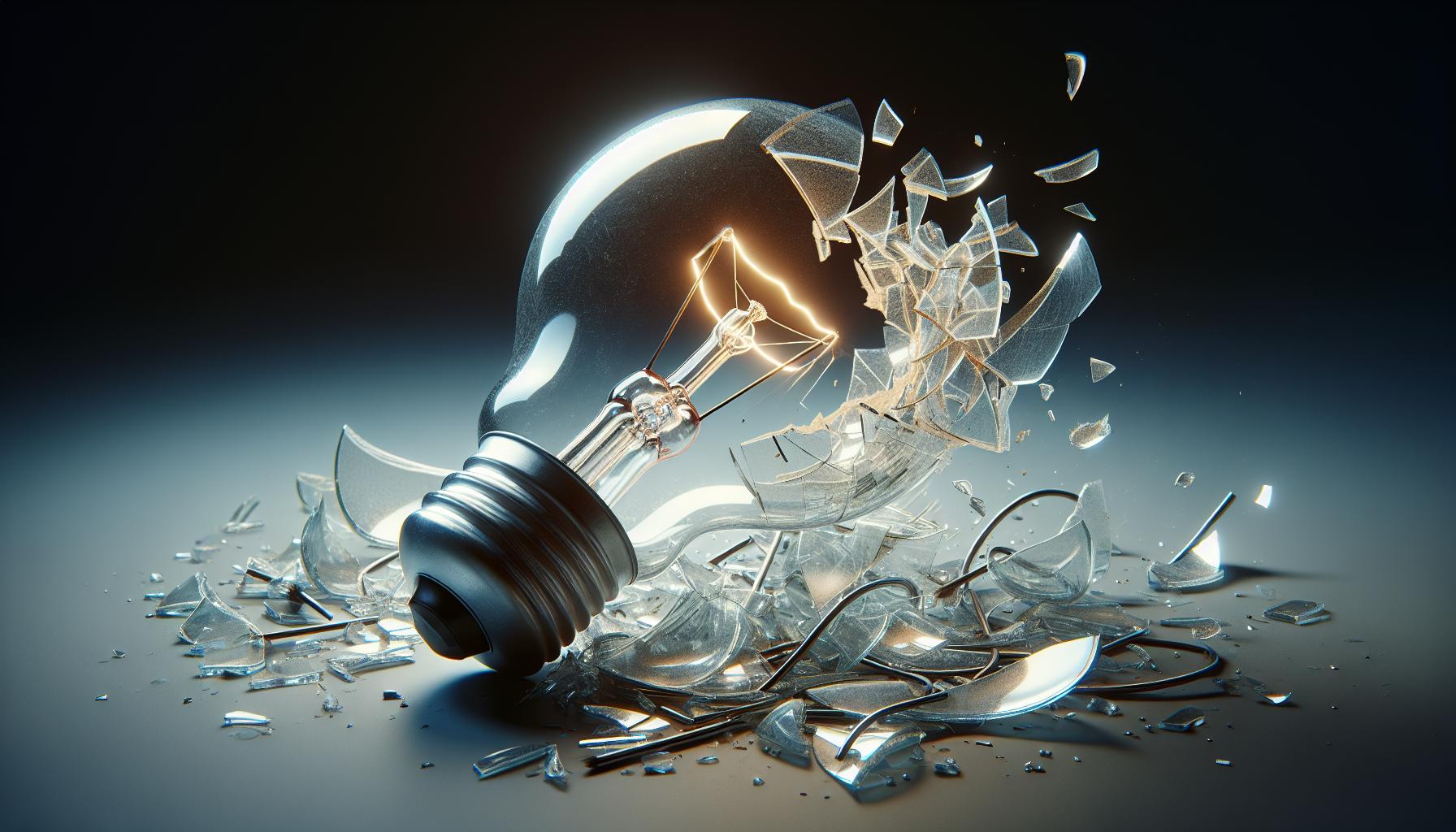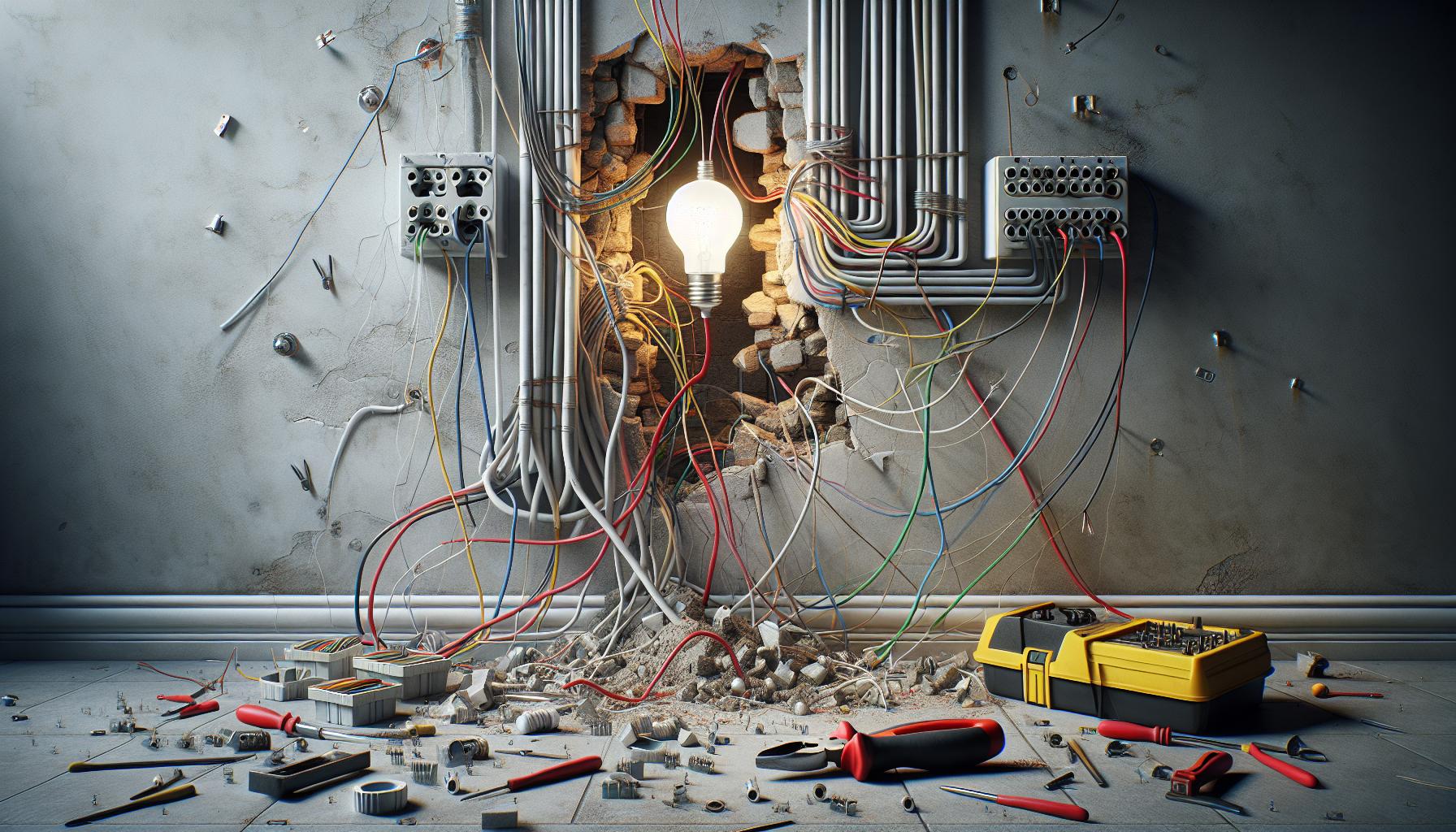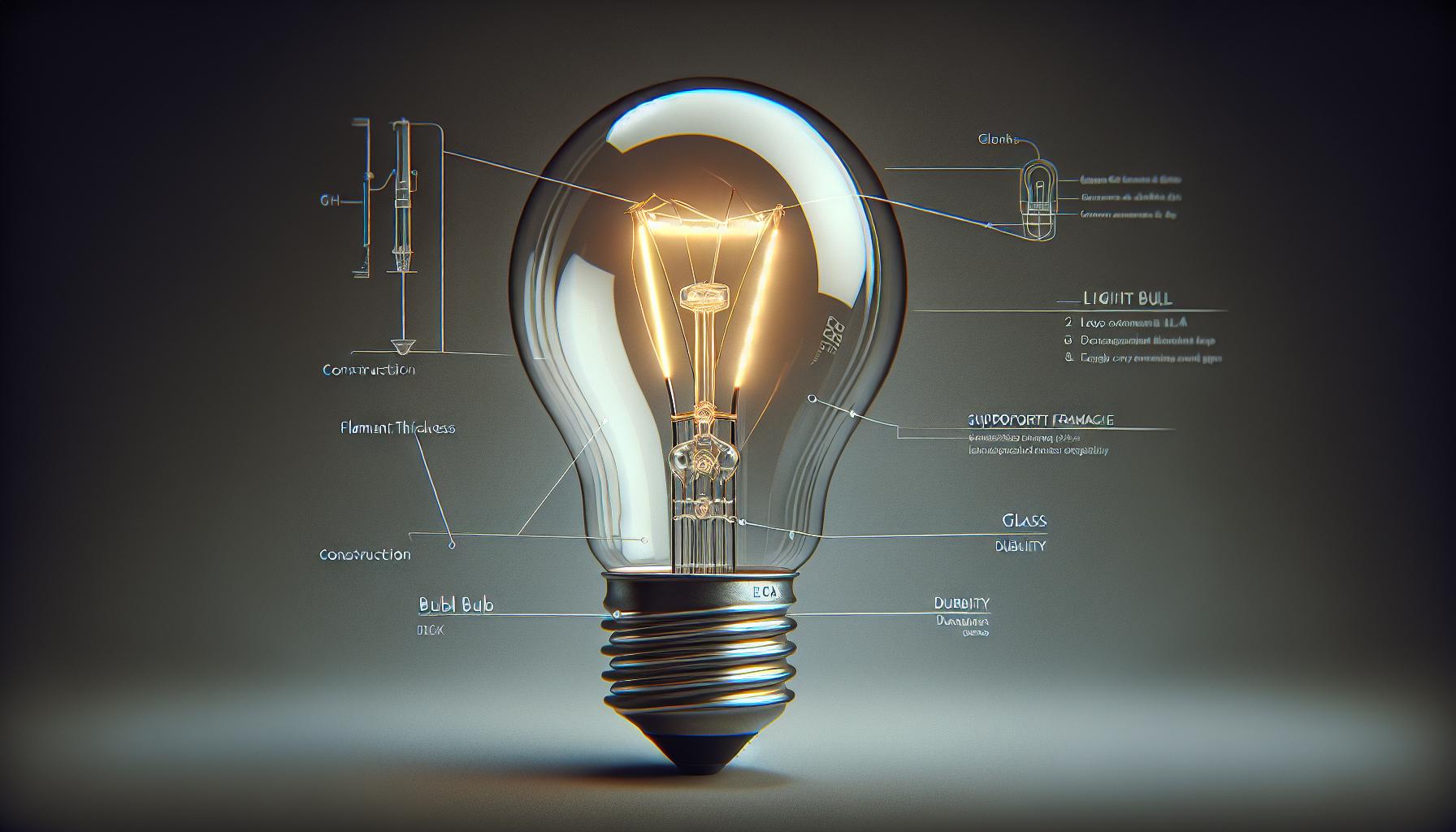Ever flipped the switch and jumped at the sound of a light bulb popping? It’s startling, isn’t it? You’re left in the dark, wondering what just happened. Light bulbs aren’t supposed to go out with a bang, but sometimes they do.

Causes of Light Bulbs Exploding
Encountering a light bulb explosion can be quite unsettling. As someone who’s passionate about DIY and all things lighting, you may wonder why it happens. While it’s not the norm for your light bulbs to make dramatic exits, various factors can lead to these startling moments.
Poor Quality or Defective Bulbs often top the list. Inexpensive or low-quality bulbs may have flaws in the glass or improper filament placement, creating hot spots. Over time, these hot spots can cause the glass to weaken, and when you flick the switch, the sudden surge can push it past its breaking point.
Overheating is another usual suspect. Light fixtures are designed to dissipate heat efficiently, but when they’re covered with insulating materials like fabric or incorrectly installed within confined spaces, the heat can build up. If the bulb’s base gets too hot, it may damage the socket and lead to an electrical arc, which can cause the bulb to explode.
Then there’s the Voltage Spike scenario. Your home’s electrical system is supposed to provide a stable voltage, but occasionally, something goes wrong. Sudden spikes in your home’s electrical voltage can overload the bulb, resulting in an explosive goodbye.
Loose Connections also can’t be ignored. If a bulb is not screwed in properly, it may wobble or sit at an odd angle. This poor contact can create arcs and excessive heat, ultimately resulting in a bulb’s catastrophic failure.
Let’s not forget about Water or Moisture. In rooms like the bathroom or outdoors where humidity and moisture are present, droplets can make their way onto the bulb. The rapid cooling effect of water on the hot glass can lead to a stress fracture and a potential explosion.
Understanding these causes helps you to take preventive measures. Checking the quality of bulbs before purchase, ensuring proper installation, and keeping an eye on the conditions of your electric connections can go a long way in safeguarding against unexpected light bulb pyrotechnics.
Overheating as a Common Factor

When you flick on a light switch, your bulb’s expected to glow warmly, not pop with excitement. However, heat is a key player in many light bulb dramas. Overheating’s not just about a bulb getting too hot to touch; it’s a potentially explosive issue. Let’s shed some light on how this sneaky culprit can cause your bulb to burst into pieces rather than bask in luminous glory.
Poor design or inadequate heat dissipation can cause bulbs, especially incandescents and halogens, to overheat. The filament inside gets extremely hot during operation. If the heat’s not managed well, it builds up, the material weakens, and—you guessed it—you’re now one bulb short, possibly with a mess of glass to clean up. That’s why you’ll often see bulbs with metal bases or heat sinks; they’re there to cart away unwanted heat.
In your quest to brighten up your space, you might be inadvertently contributing to this problem. Ever popped a bulb with a higher wattage into a lamp that wasn’t designed for it? You’re not alone. The thrill of more lumens can overshadow the risk, but that lamp’s specifications are there for a reason. Surpass the recommended wattage, and you’re essentially stoking the fire within the bulb—the risk of overheating skyrockets.
Let’s talk LED for a sec—these modern marvels aren’t immune to heat issues either. They might run cooler than their filament-holding cousins, but bad placement can lead to their downfall. Cramming an LED into an enclosed fixture with poor ventilation is like wearing a parka in the desert; things are bound to get too hot.
And don’t even get me started on the effects of dust and dirt accumulation. Not only does it dim your light’s brilliance, but it also acts like a cozy blanket, trapping heat. Keeping your bulbs clean might seem like a chore, but it’s a straightforward way to maintain their chill.
Lighting’s meant to brighten your life, not scatter it in sparkly yet sharp fragments across your floor. So when you’re shopping for bulbs or looking at light fixtures, think cool thoughts—not just for the ambiance, but for safety’s sake too. Keep that air flowing and adhere to wattage guidelines, and you’ll be set for a steady burn rather than a startling bang.
The Role of Voltage Fluctuations
« Do LED Light Bulbs Use Less Electricity? Uncover Energy Savings
How Do I Know What Size Light Bulb Base: Find the Perfect Fit for Brightness & Safety »

When you flick that switch, the expectation is a steady glow, but sometimes an unexpected surge results in a light bulb’s shattering exit. Voltage fluctuations are a notorious culprit in these explosive incidents. As a DIY enthusiast and lighting aficionado, you’re familiar with the havoc inconsistent electricity can wreak on your home appliances—light bulbs are no exception.
Electrical supply isn’t always a steady stream; it’s more like a river with ebbs and flows. Surges—brief spikes in voltage—are particularly damaging. They send a sudden jolt of electricity that can overwhelm a bulb’s delicate filament. Imagine bench pressing beyond your limit, and then someone drops an extra weight on the bar—that’s your filament during a surge, buckling under unexpected pressure.
On the flip side, ‘brownouts’—reductions in voltage—can also have adverse effects. They strain the bulb by forcing it to operate without sufficient power, much like trying to cycle uphill with tires half-deflated. This straining can cause wear on the filament and result in a weakened state, prone to breakage the next time a surge occurs.
How Voltage Affects Bulb Lifespan
Voltage fluctuations can shorten the lifespan of bulbs dramatically. Here’s a quick look at the stats:
| Electrical Situation | Potential Lifespan Reduction |
|---|---|
| Surge (Overvoltage) | Up to 70% |
| Brownout (Undervoltage) | Up to 60% |
To defend your light bulbs against this unseen adversary, surge protectors can be a practical solution. They act as buffers, absorbing or redirecting the excessive energy away from your bulbs and other electronics. Additionally, choosing voltage-regulated LED bulbs can also help since these are designed to cope with fluctuations more efficiently than their incandescent or halogen counterparts.
Remember, consistent voltage is key to keeping bulbs intact. Whether outfitting a cozy reading nook or illuminating a hand-crafted table lamp, giving a nod to voltage stability can make all the difference in the pursuit of perfect lighting. Keep an eye on your home’s electrical flow to keep your bulbs glowing strong.
Incorrect or Faulty Wiring

Ever wonder why a light bulb might suddenly go kaboom when you flip the switch? You’re not alone. Faulty Wiring is one of those sneaky culprits that often gets overlooked. It’s like setting the stage for an unwelcome surprise the moment you’re seeking illumination.
Imagine the wires behind your walls as veins, pulsing with electric life. They’re supposed to deliver power smoothly and steadily, but when they’re installed incorrectly or get damaged, things get dicey. Your light bulbs are sensitive to these anomalies; suffice it to say, they’re not fans of electrical hiccups.
Here’s the scoop: wires and connections that haven’t been installed with a keen eye for detail can lead to loose contacts. Think of a loose contact as a fickle handshake between the power supply and your bulb, one that can generate heat and ultimately lead to a light bulb’s early demise. A poor connection acts like a resistor, heating up the bulb’s base, and sometimes the whole thing ends in a dramatic pop!
And that’s not all. Aging wiring can also be the source of trouble. Over time, wires can become brittle or the insulation can break down, exposing the copper underneath. This can create short circuits, which are about as beneficial to your light bulbs as a chainsaw is to a birthday cake.
To mitigate these risks, it’s crucial to check the wiring during:
- Home renovations
- Bulb replacement
- Installation of new fixtures
Don’t let subpar wiring pull the plug on your home’s tranquility. If you’re into DIY, make sure you’re up to date on proper wiring standards or call in a pro. When it comes to electrical safety, there’s no shame in getting a helping hand. Remember, your light bulbs are counting on you for a safe and stable environment to shine bright.
Quality and Durability of Light Bulbs

When you’re replacing a bulb or installing new light fixtures in your DIY project, the quality and durability of the light bulbs you choose can play a significant role in their longevity and safety. Higher-quality bulbs typically feature better filament designs and more robust construction, which reduces the risk of premature failure.
Manufacturers use various materials and manufacturing techniques to enhance the durability of light bulbs. For instance, LED bulbs often have a heat sink to manage thermal output, while incandescents might use krypton gas to prolong the filament’s life. Here’s what you need to pay attention to:
- Filament thickness and material quality
- The presence of a support frame around the filament
- Envelope or bulb glass thickness
Bulbs of lesser quality are more susceptible to manufacturing defects, including thin glass prone to stress and microfractures. These defects can become the weak links that lead to an explosion when the bulb is turned on and subjected to a sudden change in temperature or electrical stress.
Branded bulbs often undergo more rigorous testing and quality control, ensuring that each piece meets the industry standards for performance and safety. On the other hand, off-brand and generic bulbs might not have the same level of scrutiny applied to their production, potentially leaving you with a batch of light bulbs more likely to fail.
When shopping for bulbs, consider looking at the:
- Ratings and reviews from other consumers
- Lamp’s wattage compatibility
- Manufacturer’s warranty
Regular inspection of your bulbs can also help you identify any potential issues before they lead to an explosion. Look for signs of wear, black spots, or flickering, and replace bulbs as needed to maintain a safe and well-lit environment in your home. With the right knowledge and material choices, you’ll enhance the safety and efficiency of your lighting, ensuring that each flick of the switch illuminates your space without a hint of trouble.
Conclusion
You’ve seen that light bulb explosions, while rare, can be pretty unsettling. Remember, the key to prevention lies in being proactive—choose quality bulbs, check your wiring, and be mindful of wattage compatibility. Don’t skimp on these details; it’s about more than just light—it’s about your safety. If you’re ever in doubt, it’s worth having a professional take a look. After all, a little caution goes a long way in keeping your home bright and safe. Stay illuminated and secure!
Frequently Asked Questions
What are the common causes of light bulbs exploding?
Poor quality or defective bulbs, overheating, voltage spikes, loose connections, and exposure to water or moisture are common causes of light bulb explosions.
Can faulty wiring cause light bulb explosions?
Yes, faulty wiring, such as loose contacts and aging wires, can generate heat that may lead to bulb explosions.
How does bulb quality affect the likelihood of explosion?
Higher-quality bulbs are designed with better filaments and more durable materials, reducing the risk of premature failure and explosions.
Are branded light bulbs less likely to explode?
Branded light bulbs typically undergo more rigorous testing and quality control, making them meet industry standards and less likely to explode.
What can consumers do to prevent light bulb explosions?
Consumers should regularly inspect bulbs, pay attention to ratings, reviews, wattage compatibility, and adhere to manufacturer warranty guidelines to mitigate the risk of explosions.




